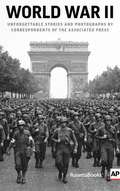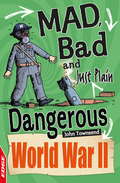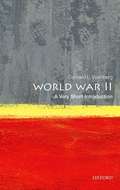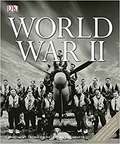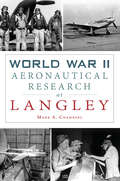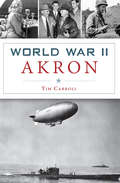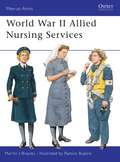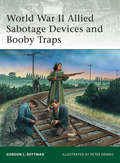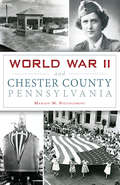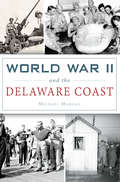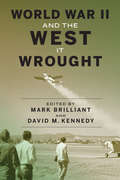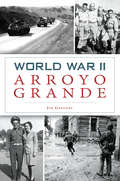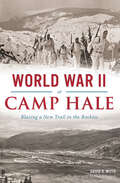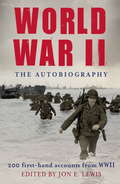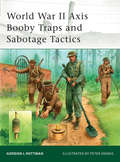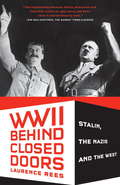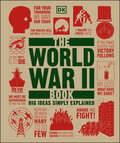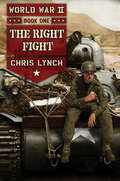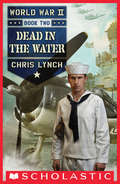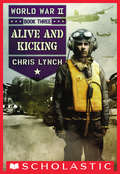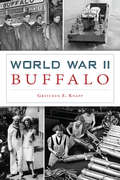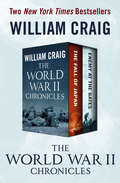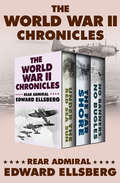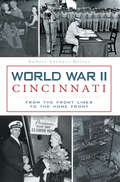- Table View
- List View
World War II: Unforgettable Stories and Photos by Correspondents of The Associated Press
by The Associated PressPowerful, visceral, and essential to preserving and understanding our past, the work of Associated Press photographers and journalists lives on through the pages of World War II.Never before in history had the day-to-day struggles and victories of war—from the home front to the front lines—been chronicled in such graphic and unflagging detail as during the Second World War. Nearly 200 photographers and reporters of Associated Press volunteered to cover the war across the globe from 1939 through 1945. The heroic achievements of these reporters and photographers—some of whom gave their lives—are remembered through the stunning photographs and moving firsthand reports of World War II: Unforgettable Stories and Photographs by Correspondents of The Associated Press.World War II commemorates the experiences of the individuals who brought the war into the homes of millions of Americans. Originally published in 1945 as Reporting to Remember: Unforgettable Stories and Pictures of the War by Associated Press Correspondents, this updated anniversary edition includes a new interview with former AP World War II correspondent George Bria, as well as a new Foreword by current AP Vice President for International News John Daniszewski.
World War II (EDGE: Mad, Bad and Just Plain Dangerous #4)
by John TownsendTime to take a sideways look at the bizarre and outrageous from throughout history - and it's all TRUE!Which mad weapons were actually used during combat? Who was the bad guy in charge of the Nazi German air force? Which dangerous mission helped to capture the Nazis' new tank?Find out the answers to these questions inside, along with lots of facts, quizzes, and other bonkers stuff as you take a bumpy journey into the darkest crannies of World War II history with Mad, Bad and Just Plain Dangerous!
World War II: A Very Short Introduction (Very Short Introductions Series)
by Gerhard L. WeinbergThe enormous loss of life and physical destruction caused by the First World War led people to hope that there would never be another such catastrophe. How then did it come to be that there was a Second World War causing twiceas much loss of life and more destruction than any other previous conflict? In this Very Short Introduction, Gerhard L. Weinberg provides an introduction to the origins, course, and impact of the war on those who fought and the ordinary citizens who lived through it. Starting by looking at the inter-war years and the German invasion of Poland in September 1939, he examines how the war progressed by examining a number of key events, including the war in the West in 1940, Barbarossa, the German Invasion of the Soviet Union, the expansion of Japan's war with China, developments on the home front, and the Allied victory from 1944-45. Exploring the costs and effects of the war, Weinberg concludes by considering the long-lasting mark World War II has left on society today.
World War II
by H. P. WillmottA dramatic new illustrated account of the most destructive war the world has ever seen
World War II Aeronautical Research at Langley (Military)
by Mark A. ChambersThe effort to win the war began at home--and for the researchers at Langley Memorial Aeronautical Laboratory, enhancing America's military aviation arsenal was the key to victory.Formed in 1915, the National Advisory Committee for Aeronautics established itself over the next 25 years as one of the world's finest research organizations. When World War II began in 1939, the NACA employed a mere 500 workers and maintained a budget slightly in excess of $4 million. To meet the demands of the war, a special partnership was quickly forged between NACA researchers, industry designers, and military planners. The Langley laboratory possessed world class aeronautical research facilities and flight research operations, making it ideally suited to help America win the war.Military historian Mark Chambers tells the story of the monumental task of developing the planes that spurred Allied victory in World War II.
World War II Akron (Military)
by Tim CarrollWhen World War II engulfed the nation, the men and women of Akron dutifully played their part in the epic struggle. Keyes Beech ducked grenades as marines raised the American flag at on Iwo Jima. Newspaper magnate John S. Knight watched the Japanese surrender on the USS Missouri just five months after his son was killed in Germany. On the homefront, Goodyear manufactured blimps used to hunt down Nazi submarines, and noted Beacon Journal cartoonist Web Brown pledged his talent and his pen to boosting morale at home and abroad. Replete with more than one hundred images, including many of Brown's wartime drawings, this thrilling account by local author Tim Carroll recalls all that Akron gave for freedom.
World War II Allied Nursing Services
by Martin Brayley Ramiro BujeiroThe skill and care of the women of the Allied military nursing services was remembered gratefully by hundreds of thousands of wounded servicemen of World War II (1939-1945). The small peacetime services increased rapidly by enrolling reservists and volunteers; the great majority of the nurses who cared for Allied casualties were 'civilians in uniform', who worked tirelessly under difficult conditions and - in tented hospitals close to the front lines - in real danger; many nurses paid for their devotion with their lives. This first-ever fully illustrated study of the US, British, Commonwealth, and other nursing organisations includes many unpublished photographs and 24 meticulously illustrated colour figures.
World War II Allied Sabotage Devices and Booby Traps
by Gordon Rottman Peter DennisOsprey's elite title dealing with various sabotage devices and booby traps that were used by the British and the Americans during World War II (1939-1945). Following Churchill's directive to set occupied Europe ablaze, the SOE and later its American sister organization, the OSS, were deployed across the continent. Outnumbered, surrounded and in great peril, these brave agents were armed with a wide variety of devices to help them achieve their objectives, including numerous pieces of sabotage equipment and cunning booby traps. This book examines these different pieces of equipment and the technicalities involved in deploying them effectively. It also discusses the specialist equipment developed by Special Forces units, including the SAS Lewes Bomb. Touching on some of the stranger developments, such as explosives disguised as lumps of coal, the author goes on to describe the German clearance techniques that were developed to avoid these dangers.Complete with specially commissioned artwork and period diagrams, together with detailed descriptions of the dangerous missions of Allied agents, this book is a fascinating insight into the secret war behind enemy lines.
World War II and Chester County, Pennsylvania (Military)
by Marion M. PiccolominiRegiments from Chester County fought bravely in all theaters of World War II, while locals at home took extraordinary measures to support the Allies. West Chester resident G. Raymond Rettew developed a process to mass produce vitally needed penicillin while a peaceful farm transformed into the bustling Valley Forge General Hospital in 1943. Women entered labor positions at companies, including Lukens Steel, to meet production demands. The Coatesville YMCA created and distributed a newsletter to soldiers so the boys on the front had the news from back home. Author Marion Piccolomini celebrates the resilience and perseverance of Chester County residents in the midst of total war.
World War II and Mexican American Civil Rights
by Richard Griswold Del CastilloWorld War II marked a turning point for Mexican Americans that fundamentally changed their expectations about how they should be treated by the greater U. S. society. The experiences of fighting alongside white Americans in the military, as well as of working in factory jobs for wages equal to those of Anglo workers, made Mexican Americans less willing to tolerate the second-class citizenship that had been their lot before the war. Having proven their loyalty and "Americanness" during World War II, Mexican Americans in the postwar years wanted to have the civil rights they knew they had earned. In this book, Richard Griswold del Castillo and Richard Steele investigate how the World War II experiences of Mexican Americans galvanized their struggle for civil rights and how the U. S. government responded to the needs and aspirations of Mexican Americans. The authors demonstrate, for example, that the U. S. government "discovered" Mexican Americans during World War II and set about addressing some of their problems as a way of forestalling a sense of grievance and disaffection that might have made the Mexican American community unwilling to support the war effort. The authors also show that, as much or more than governmental programs, the personal wartime experiences of Mexican Americans formed their civil rights consciousness. The book concludes with a selection of key essays and historical documents from the World War II period that collectively gives a first-person understanding of the civil rights struggles of Mexican Americans.
World War II and the Delaware Coast (Military)
by Michael MorganWithin weeks of Pearl Harbor, German U-boats arrived off the Delaware coast and attacked numerous ships along the vital shipping lanes to Philadelphia and Wilmington. On February 28, 1942, two German torpedoes hit the destroyer Jacob Jones, which was carrying more than one hundred American sailors. It sank in less than an hour. A center for military activity, Lewes became a refuge for many survivors from such attacks. The dunes along Cape Henlopen hid the massive artillery batteries of Fort Miles. Residents of the beachfront communities rallied amid the blackout regulations and air raid drills with rationing and scrap drives. Spotters watched for enemy warships in concrete towers that still line the coast. Author Michael Morgan tells the remarkable story of a coast at war.
World War II and the West It Wrought
by Mark Brilliant David M. KennedyFew episodes in American history were more transformative than World War II, and in no region did it bring greater change than in the West. Having lifted the United States out of the Great Depression, World War II set in motion a massive westward population movement, ignited a quarter-century boom that redefined the West as the nation's most economically dynamic region, and triggered unprecedented public investment in manufacturing, education, scientific research, and infrastructure—an economic revolution that would lay the groundwork for prodigiously innovative high-tech centers in Silicon Valley, the Puget Sound area, and elsewhere. Amidst robust economic growth and widely shared prosperity in the post-war decades, Westerners made significant strides toward greater racial and gender equality, even as they struggled to manage the environmental consequences of their region's surging vitality. At the same time, wartime policies that facilitated the federal withdrawal of Western public lands and the occupation of Pacific islands for military use continued an ongoing project of U.S. expansionism at home and abroad. This volume explores the lasting consequences of a pivotal chapter in U.S. history, and offers new categories for understanding the post-war West. Contributors to this volume include Mark Brilliant, Geraldo L. Cadava, Matthew Dallek, Mary L. Dudziak, Jared Farmer, David M. Kennedy, Daniel J. Kevles, Rebecca Jo Plant, Gavin Wright, and Richard White.
World War II Arroyo Grande (Military)
by Jim GregoryOn December 7, 1941, war came to Arroyo Grande when two local sailors were killed on the USS Arizona at Pearl Harbor. People from the small town were thrust into great circumstances and quickly answered the call for action. A local storekeeper's son won the Silver Star after he brought his flaming B-17 safely back to base. A valley farmworker served with the famed 442nd Regimental Combat Team, largely composed of soldiers of Japanese descent. Chinese guerrillas commanded by Mao Zedong--the future Chairman Mao--threw a birthday party for an Arroyo Grande soldier. At home, community groups like the Arroyo Grande Women's Club brought packed lunches for their Japanese American neighbors on the morning they were forced to leave for the internment camps. Local author Jim Gregory brings to life the sorrows and triumphs of a dramatic period in local history.
World War II at Camp Hale: Blazing a New Trail in the Rockies (Military Ser.)
by David R WitteIn April 1942, a little over two years before the Tenth Mountain Division officially obtained its name, the U.S. Army began the unprecedented construction of a training facility for its newly acquired ski and mountain troops. Located near Pando in Colorado's Sawatch Range, the site eventually known as Camp Hale sits at an elevation of 9,250 feet. Immense challenges in its creation and subsequent training included ongoing racial conflict, the high altitude and blustery winters. However, thanks to contributions from civilian workers and the Women's Army Corps and support from neighboring communities, the camp trained soldiers who helped defeat the Axis powers in World War II. Veteran David R. Witte brings to life this enduring story.
World War II: 200 First-Hand Accounts from WWII
by Jon E. LewisA remarkable series of over 200 eye-witness accounts taken from diaries, letters, speeches, interviews and memoirs of those who were there: pilots, sailors, generals, infantrymen, war correspondents and leaders. These include Spitfire pilot Richard Hillary's account of bailing out of his plane in the Battle of Britain; a German sailor's view of HMS Royal Oak being torpedoed at Scapa Flow; insights into Rommel's ailing health from a lieutenant in the Afrika Korps; famous war correspondent Ernie Pyle's account of GI meals during Operation Torch; Anne Frank's recollection of the rounding up of Jews in Amsterdam; the last letters home from anonymous German soldiers in Stalingrad; the view from a Japanese cockpit over Pearl Harbor on 7 December 1941; a German officer's memories of the airborne assault on Crete in May 1941; the firestorm following the bombing of Dresden in July 1943 in the words of a German woman; a lieutenant in the 1st Airborne Divsion's eyewitness account of the fighting in Arnhem; Martha Gellhorn on the aftermath of the Battle of the Bulge; a British tank officer crossing the German border on 28 February 1945; on the Kokoda Trail in New Guinea; an Allied intelligence officer being executed by the Japanese; the tunnels of Iwo Jima; and a kamikaze pilot's final letter.
World War II Axis Booby Traps and Sabotage Tactics
by Peter Dennis Gordon RottmanBooby traps laid by troops in war zones in World War II (1939-1945) are largely neglected in histories and memoirs, and rarely examined in detail. Yet for a soldier, the threat of booby traps was hugely significant and the ability to find and disarm them was essential. This is the first comprehensive study of World War II Axis battlefield sabotage equipment, using information from rare wartime intelligence publications covering both Allied and Axis practice to identify, illustrate and describe the vintage munitions used in World War II. Examining all aspects of this secretive subject, from the equipment used to the techniques of placing and uncovering them, this book is an invaluable resource, revealing the daily risks faced by soldiers on the ground through the course of the war.From the Trade Paperback edition.
World War II Behind Closed Doors: Stalin, the Nazis and the West
by Laurence ReesIn this revelatory chronicle of World War II, Laurence Rees, winner of the 2006 British Book Award for History, documents the dramatic and secret deals that helped make the war possible and prompted some of the most crucial decisions made during the conflict. Drawing on material available only since opening of archives in Eastern Europe and Russia, Rees re-examines the key choices made by Stalin, Churchill and Roosevelt during the war. And as the truth about Stalin's earlier friendly relationship with the Nazis is laid bare, a devastating and surprising picture of the Soviet leader emerges. The emotional core of the book is the amazing new testimony obtained from nearly a hundred separate witnesses from the period--former Soviet secret policemen, Allied seamen who braved Arctic convoys and Red Army veterans who engaged Germans in hand-to-hand fighting on the Eastern Front. Their dramatic personal experiences make clear in a compelling and fresh way the reasons why the people of Poland, the Baltic states and other European countries simply swapped the rule of one tyrant for another. Rees' ability to weave high politics--the meeting of the Allied leaders at Tehran, Yalta and Potsdam--with the dramatic personal experiences of those on the ground who bore the consequences of their decisions is eye opening. World War II Behind Closed Doors will change the way we think about the Second World War.
The World War II Book (DK Big Ideas)
by DKLearn about the rise of Adolf Hitler, Pearl Harbour and the D-Day Landings in The WWII Book.Part of the fascinating Big Ideas series, this book tackles tricky topics and themes in a simple and easy to follow format. Learn about World War 2 in this overview guide to the subject, great for beginners looking to learn and war experts wishing to refresh their knowledge alike! The WWII Book brings a fresh and vibrant take on the topic through eye-catching graphics and diagrams to immerse yourself in. This captivating book will broaden your understanding of World War 2, with:- More than 100 ground-breaking ideas on the Second World War- Packed with facts, charts, timelines and graphs to help explain core concepts- A visual approach to big subjects with striking illustrations and graphics throughout- Easy to follow text makes topics accessible for people at any level of understandingThe World War II Book is the perfect introduction to the biggest war in history, aimed at adults with an interest in the subject, and politics and history students wanting to gain more of an overview. Here you&’ll discover more than 90 of the key ideas and events during and surrounding the conflict, through exciting text and bold graphics. If you&’ve ever wanted to know the crucial events of World War 2 and the people behind them, this is the perfect book for you.Your World War 2 Questions, Simply ExplainedDiscover the key battles, tactics, technologies and turning points of the Second World War – the epic conflict that shaped the modern world. If you thought it was difficult to learn about the many events and key figures of World War 2, The WWII Book presents vital information in a clear layout. From Fascism in the 1930s to Pearl Harbor, Hitler and Nazi Germany to the bombing of Hiroshima - fantastic mind maps and step-by-step summaries will teach you all the main concepts. The Big Ideas SeriesWith millions of copies sold worldwide, The WWII Book is part of the award-winning Big Ideas series from DK. The series uses striking graphics along with engaging writing, making big topics easy to understand.
World War II Book 1: The Right Fight (World War II #1)
by Chris LynchThe author of the acclaimed Vietnam series sets his sights on World War II. There are few things Roman loves as much as baseball, but his country is at the top of the list. So when it looks like the United States will be swept up into World War II, he turns his back on baseball and joins the US Army. Roman doesn't mind. As it turns out, he is far more talented with a tank than he ever was with a baseball. And he is eager to drive his tank right into the field of battle, where the Army is up against the fearsome Nazis of the Afrika Korps. The North African terrain is like nothing Roman has ever known, and desert warfare proves brutal. As Roman drives his team deeper into disputed territory, one thing becomes very clear: Life in wartime is a whole new ball game.
World War II Book 2: Dead in the Water (World War II #2)
by Chris LynchThe author of the acclaimed Vietnam series sets his sights on World War II. Critically acclaimed author Chris Lynch provides an action-oriented but thoughtful view of the US Navy's war in the Pacific. Hank and Theo are brothers who share everything, including a sense of duty a love of baseball. They have been inseparable for their entire lives. But when America is drawn into World War II, the young brothers find themselves fighting the same war on opposite sides of the globe. As an airedale in the Navy, Hank now lives aboard an aircraft carrier, the USS Yorktown. His job is to assist the pilots who soar off each day to engage Japanese forces in the Pacific Ocean. It is a crucial and terrifying duty in the wake of the attack on Pearl Harbor. As the days at sea become weeks and months, Hank adapts to life apart from his family. He even adapts to the fear of torpedoes. But in an era of prejudice and segregation, it's Hank's choice of friends that might prove most dangerous of all.
World War II Book 3: Alive and Kicking (World War II #3)
by Chris LynchThe author of the acclaimed Vietnam series sets his sights on World War II. "All the sizzle, chaos, noise and scariness of war is clay in the hands of ace storyteller Lynch." - KIRKUS REVIEWS Theo has always looked up to his older brother, Hank, but never more so than the day Hank enlisted in the US Navy. Not to be outdone, Theo followed his older brother's lead in joining the war effort -- but preferring the wide open sky to the untamed ocean, Theo chose to serve with the Army Air Force. As a gunner on a B-24 Liberator, Theo is enthusiastic about his crew's mission to save all of Europe from the Nazis. Fearlessness is a requirement for dog fights at 50,000 feet. But when Theo's brother goes missing in the Pacific, fear start creeping in. Can Theo keep his head in the game while he awaits word of his brother's fate?
World War II Buffalo (Military)
by Gretchen E. KnappWhen President Roosevelt visited Buffalo in November 1940, he found a hardworking city with a large immigrant population manufacturing aircraft for the Allies. Nearby Fort Niagara inducted over 100,000 young men, resulting in an acute labor shortage. American Brass, Bell Aircraft, Chevrolet, Curtiss-Wright, Houde Engineering and Republic Steel reluctantly, then gladly, hired women. More than 300,000 defense workers toiled in hot factories for high wages despite transportation, housing and food shortages. The aircraft plants alone employed 85,000 on forty-eight-hour workweeks. Buffalonians watched the flag raising at Iwo Jima, participated in the Manhattan Project and observed the formal surrender of Japan in Tokyo Bay. Author Gretchen Knapp brings to life the challenges and contributions of daily life during wartime.
The World War II Chronicles: The Fall of Japan and Enemy at the Gates
by William J. CraigA &“virtually faultless&” account of the final weeks of World War II in the Pacific and the definitive history of the battle for Stalingrad together in one volume (The New York Times Book Review). Author William Craig traveled to three different continents, reviewed thousands of documents, and interviewed hundreds of survivors to write these New York Times–bestselling histories, bringing the Eastern Front and the Pacific Theater of World War II to vivid life. The Fall of Japan masterfully recounts the dramatic events that brought an end to the Pacific War and forced a once-mighty nation to surrender unconditionally. From the ferocious fighting on Okinawa to the all-but-impossible mission to drop the second atom bomb, and from Franklin D. Roosevelt&’s White House to the Tokyo bunker where tearful Japanese leaders first told the emperor the war was lost, Craig draws on Japanese and American perspectives to capture the pivotal events of these climactic weeks with spellbinding authority. Enemy at the Gates chronicles the bloodiest battle of the war and the beginning of the end for the Third Reich. On August 5, 1942, giant pillars of dust rose over the Russian steppe, marking the advance of Hitler&’s 6th Army. The Germans were supremely confident; in three years, they had not suffered a single defeat. The siege of Stalingrad lasted five months, one week, and three days. Nearly two million men and women died, and the 6th Army was completely destroyed. The Soviet victory foreshadowed Nazi Germany&’s downfall and the rise of a communist superpower. Heralded by Cornelius Ryan, author of The Longest Day, as &“the best single work on the epic battle of Stalingrad,&” Enemy at the Gates was the inspiration for the 2001 film of the same name, starring Joseph Fiennes and Jude Law.
The World War II Chronicles: Under the Red Sea Sun, The Far Shore, and No Banners, No Bugles
by Rear Admiral Edward EllsbergA navy admiral&’s firsthand accounts of three triumphant operations in Europe and North Africa during World War II. After the attack on Pearl Harbor, naval engineering genius Edward Ellsberg came out of retirement to serve his country once again. In these three riveting histories, he recounts the incredible salvage missions and audacious battle plans he took part in during the Second World War. Under the Red Sea Sun: In 1942, Mussolini&’s forces were on the run in East Africa. At Massawa, Eritrea, the fleeing Italians left the largest mass wreck in the world, turning a vital port into a tangle of shattered ships and dangerous booby traps. In order to continue the war effort and push back the Axis powers in Africa, the Allies enlisted Commander Ellsberg, who navigated the complicated American and British bureaucracies to pull off a historic feat of engineering—the largest of its kind the world had ever seen. The Far Shore: Rear Admiral Ellsberg describes in detail the meticulous preparation and efforts behind the Normandy Invasion—efforts that would keep the flow of men and materials streaming onto the beaches and into the heart of Europe. From dealing with the extremes of engineering possibilities to wrestling with the knowledge that countless lives depended on the success of his intricate planning, Ellsberg worked himself into exhaustion to do his part. Vividly described by a man who saw firsthand the horrors of war and the cost of victory, The Far Shore takes readers through the brutal surf, onto the bloody beaches, and into the mind of one of World War II&’s little-known heroes. No Banners, No Bugles: In Oran, Algeria, a crucial port city, Ellsberg helped the Allies prepare for Operation Torch, the fight to reclaim North Africa from the Axis powers. As General Eisenhower&’s chief of salvage in the Mediterranean, Ellsberg had to sort out the disorganized mess left by the Vichy French and find a way to open the harbor, though his flagging health proved to be a dangerous obstacle. No Banners, No Bugles is the riveting story of how Ellsberg, the miracle worker, tackled his greatest mission yet.
World War II Cincinnati: From the Front Lines to the Home Front (Military)
by Robert Earnest MillerWorld War II transformed Cincinnati from a relatively important but parochial midwestern city into a teeming bastion of military might. While thousands served in the nation's armed forces, others contributed to rationing programs, salvage drives, blackouts and war bond rallies. Scores of community-based programs blossomed as Cincinnatians on the home front threw themselves wholeheartedly into the "total war" that Washington believed necessary for victory. After answering the call to treat domestic duty as seriously as any battleground assignment, the Queen City emerged from the war as utterly changed as the nation itself. Author Robert Miller brings to life this dramatic, patriotic period in Cincinnati's history.
